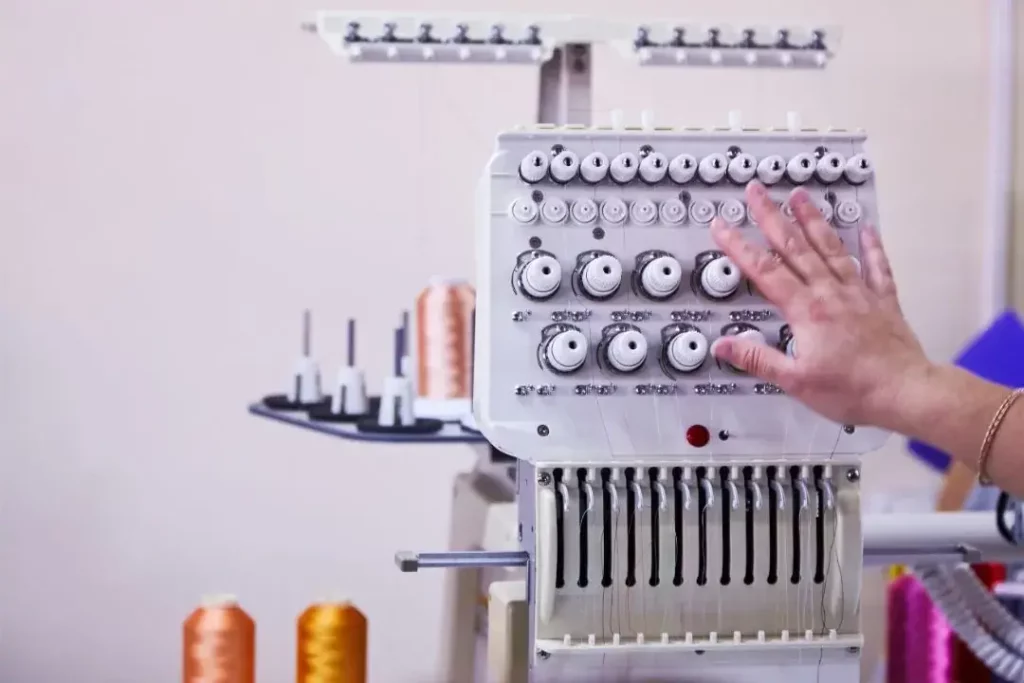Different Types of Denim Fabric
Discover the fascinating world of different types of denim fabric with our inclusive guide Understanding the different types of denim fabric, like raw denim, selvage
The One And Only Ultimate Guide You Need to Start Your Thriving Embroidery Business
Are you looking to transform your passion for embroidery into a profitable business? Starting an embroidery business might be the perfect opportunity for you to turn your hobby into a rewarding career. In this guide on how to start an embroidery business, we will take a deep dive into how to start your own embroidery business and achieve success with creativity and innovative strategies. Also explore various topics ranging from understanding what an embroidery business entails, essential equipment, and effective marketing tactics, to expanding and scaling the enterprise. Let’s lace up our business acumen!
Embroidery has immense potential when it comes to creating customized products for individuals, businesses, and organizations. The opportunities stretch beyond fashion, making it an appealing prospect for entrepreneurs with a flair for design and creativity. Moreover, with technological advancements and embroidery software, one can now deliver fast, high-quality, and precise designs on various materials, further boosting business prospects. Investing in an embroidery business promises profitable returns if one combines expert craftsmanship with effective marketing and business strategies.

An embroidery business primarily involves designing, creating, and embellishing various products with intricate and unique threadwork. This can include personalizing clothing, home décor items, and corporate promotional materials, among others. As an embroidery business owner, you will need to excel in crafting creative designs and possess the technical skills to execute them using embroidery machinery and software. Additionally, good business management and marketing abilities are necessary for efficiently running and growing your endeavor.
When starting an embroidery business, it’s essential to determine what types of services you want to offer. Some common categories include:

To kickstart your embroidery business, you will need the right tools and equipment to create high-quality products. Some essential tools and equipment include:
Highly-efficient equipment is responsible for delivering precise and consistent embroidered designs on various materials. There are different types of embroidery machines, including single-head and multi-head, which cater to specific business requirements.
Investing in high-quality threads and needles is vital to ensure your embroidery work looks professional and lasts longer. Stabilizers are essential for providing support to your fabric during embroidery, maintaining the correct tension, and ensuring a neat and consistent finish.
Essential for designing and creating digital versions of your embroidery patterns, allowing them to be transferred and executed by your embroidery machine with ease. This software also helps in resizing and editing designs or converting formats for compatibility with different machines.
When starting an embroidery business, you’ll need to decide whether to operate exclusively online or embrace a combination of online and offline business models. Both options have their pros and cons, and you must select the one that aligns with your target market, available resources, and business goals. Online business models offer you flexibility and lower overhead costs, as you can operate from home or a smaller workspace. However, relying solely on an online presence means you’ll have to work on a strong digital marketing strategy to attract clients and online sales. Offline business models, on the other hand, give you an opportunity to maintain face-to-face interactions with clients, which can help build trust and boost customer satisfaction. However, this option usually requires more investment upfront due to higher rental and operational costs for a physical store. Of course, combining both models can maximize your chances of reaching a broad audience and catering to various customer preferences. It also helps in building a strong, holistic brand presence.
So the first step in learning how to start an embroidery business is to perform a thorough market analysis to understand the industry landscape, trends, and opportunities for growth. Here are the critical components of market analysis and strategy development:
Understand who your potential customers are, their needs, preferences, and market segments you want to cater to. Develop customer personas to visualize and narrow down your ideal clients.
Analyze your competitors’ strengths, weaknesses, and strategies. Look for gaps in the market that might present unique opportunities for your business. This will help you differentiate yourself from similar businesses.
Determine what makes your embroidery business stand out and focus on these unique aspects when promoting your services. Ensure that your USPs are consistent throughout your marketing materials.
A well-structured business plan is necessary to guide your embroidery business toward success. Your plan should include:
Defining your mission and vision: Your mission statement should outline your business’s purpose, while the vision statement depicts your long-term aspirations.
Setting short-term and long-term goals: Create achievable, measurable, and specific objectives for your business, both short-term and long-term, to keep you focused and motivated.
Financial planning and budgeting: Prepare a realistic budget to manage your expenses and monitor the financial health of your business. Include projected financial statements to estimate revenue, expenses, and profitability.
Starting an embroidery business involves complying with various legal requirements and registrations, including:
Choose a suitable legal structure for your business (e.g., sole proprietorship, partnership, or corporation) and register it with the appropriate local and national authorities.
Familiarize yourself with your tax obligations and establish proper accounting practices to maintain accurate financial records. Consult a professional accountant or tax advisor to ensure compliance with tax laws and regulations.
Acquire any necessary licenses and permits, which may vary based on your location and business model. Check with your local government or a legal advisor to ensure you have all the required permissions.
Developing a strong brand and implementing effective marketing strategies are key to attracting and retaining customers in the embroidery business. Some essential elements to build your brand and market your business include:
Design a memorable and visually appealing logo that reflects your embroidery business’s essence. Maintain consistency in your branding elements, such as colors and typography, across all communication platforms.
Set up and maintain accounts on major social media platforms (e.g., Facebook, Instagram, LinkedIn) to showcase your embroidery work, connect with customers, and build a loyal following for your business.
Employ a mix of digital and traditional marketing techniques, such as paid advertising, content marketing, email marketing, and offline events, to reach a broad audience and promote your services effectively.
Attend industry events, trade shows, and join local business associations to establish connections with potential clients, suppliers, and partners. Strong relationships within the community can significantly benefit your embroidery business.
The location of your embroidery business can play a vital role in its success and growth. Some factors to consider while selecting a location include:
Ensure that your embroidery business is situated close to the customers you aim to serve so that it is easily accessible for them.
Choose a location that is easy to find and navigate for both your customers and suppliers. Consider factors such as public transportation, parking availability, and road infrastructure.
Analyze the business environment of the location, considering aspects like competition, costs, and support available from local authorities or business associations.
Determine whether you want to operate from a home-based or commercial setup. Home-based businesses can save on rent and utility costs, but commercial spaces often provide better visibility and the ability to serve more customers. Consider your budget, growth plans, and customer preferences when making this decision.
To ensure your embroidery business generates a steady stream of revenue, implement appropriate pricing and income-generating strategies like:
Determine the right pricing model for your embroidery services, factoring in costs, competitors, the target audience, and desired profit margin.
Attract customers and encourage repeat business with seasonal sales, package deals, and loyalty discounts.
Diversify your business by offering complementary products or services like sewing classes, selling embroidery materials, or designing exclusive embroidery collections. This strategy can help widen your customer base, increase sales, and create additional revenue opportunities.
As your embroidery business grows, you’ll need a capable and skilled team to help you manage the workload efficiently. Consider the following when hiring and managing staff:
Outline the specific roles and responsibilities required within your business, like embroidery technicians, designers, customer service representatives, and sales executives.
Put in place procedures to find, interview, and recruit the right candidates for your business. You can advertise job vacancies on job boards, social media, or engage with professional recruiter agencies to streamline your recruitment process.
Provide thorough training for new hires and continuous development opportunities for existing staff in order to enhance their skills and performance in the embroidery business.
Create a positive work environment, establish open lines of communication, and offer incentives, employee benefits, or growth opportunities to retain talent and reduce employee turnover.
An efficient inventory management system is crucial to ensuring smooth operations and preventing stockouts or excessive inventory in your embroidery business. Here are some methods and tools to achieve optimal inventory management:
Implement efficient storage and organization solutions for your embroidery materials and track their usage and replenishment systematically. Barcode or inventory management software can help manage your inventory efficiently.
Store your embroidery materials like threads, needles, fabrics, and stabilizers in appropriate storage containers or cabinets that protect them from damage or exposure to elements, ensuring their quality remains consistent.
Utilize inventory management software that can track your embroidery materials, allowing you to monitor usage patterns, receive restocking alerts, and generate inventory reports. This will help you maintain a well-organized inventory system and avoid wastage or stockouts.
To foster growth and propel your embroidery business towards long-term success, consider embracing the following expansion strategies:
Explore new markets, such as expanding to international clients, catering to niche customer segments, or branching into additional types of embroidery services that complement your existing offerings.
Stay relevant and competitive within the industry by employing research and innovation to create fresh designs or develop new embroidery techniques that broaden your business’s appeal.
Form strategic partnerships or collaborate with businesses that share a similar target audience, like fashion boutiques, fabric stores, or interior design companies. This engagement can help maximize your reach, grow your customer base, and generate valuable synergies.
Regularly evaluate your embroidery business’s performance through key performance indicators (KPIs) and market feedback. Identify areas that need improvement and implement strategies to address them. By continually refining your processes, you can optimize your business operations and drive profitable growth.
In conclusion, starting a successful embroidery business requires creativity, dedication, and strategic planning. By effectively analyzing market conditions, targeting the right customers, utilizing essential embroidery equipment, managing finances, and scaling responsibly, you can create a thriving embroidery business that transforms your craft into a rewarding and profitable endeavor. With this comprehensive blog on how to start an embroidery business, we hope you have gained valuable insights and practical advice to help jumpstart your embroidery business journey, achieve success, and make a long-lasting impact within this creative industry.
The cost can range anywhere from $5,000 to $50,000 or more, depending on the size and scope of your operation or the complexity of equipment you choose.
There is a constant demand for embroidery services due to the widespread use of embroidered products in various industries, hobbies, and organizations. Embroidery services cater to individuals, businesses, educational institutions, sports teams, etc., resulting in diverse opportunities for revenue generation.
For beginners, it may take anywhere from several months to a year or more of practice and learning to become proficient in the craft. Attending workshops, taking online courses, and consistent practice can help accelerate the learning process.
Discover the fascinating world of different types of denim fabric with our inclusive guide Understanding the different types of denim fabric, like raw denim, selvage

Unraveling the Threads: A Comprehensive Guide and Ultimate Comparison between Compression Shorts VS Boxer Briefs Rijiz.co Undergarments are often an afterthought in our busy morning

What Is Mesh Lining In Shorts? Unveiling the Magical Benefits of Mesh Lining in Shorts “Exploring The Truths and Insights Behind Mesh Lining In Shorts”

How to Get Olive Oil Out of Clothes Or Garments? Explore 3 Best Methods And Techniques Rijiz.co Have you ever been cooking up a storm

The Best Fabric for Shorts: How to Choose, Wear, and Care For Your Favorite One Choose The Best Shorts Fabric for Your Summer Comfort: An

8 Most Trendy Types Of Shorts You May Love To Have In 2023 Discover The Amazing Features Of Each Types Of Shorts And Styling Tips
WhatsApp us